- State Board
-
12th Standard
-

Biology
-

Computer Applications
-

Computer Science
-

Business Maths and Statistics
-

Commerce
-

Economics
-

Maths
-

Chemistry
-

Physics
-

Computer Technology
-

History
-

Accountancy
-

Tamil
-

Maths
-

Chemistry
-

Physics
-

Biology
-

Computer Science
-

Business Maths and Statistics
-

Economics
-

Commerce
-

Accountancy
-

History
-

Computer Applications
-

Computer Technology
-

English
12th Standard stateboard question papers & Study material
தமிழ் Subjects
English Subjects
-
-
11th Standard
-

Maths
-

Biology
-

உயிரியல் - தாவரவியல்
-

Economics
-

Physics
-

Chemistry
-

History
-

Business Maths and Statistics
-

Computer Science
-

Accountancy
-

Commerce
-

Computer Applications
-

Computer Technology
-

Tamil
-

Maths
-

Commerce
-

Economics
-

Biology
-

Business Maths and Statistics
-

Accountancy
-

Computer Science
-

Physics
-

Chemistry
-

Computer Applications
-

History
-

Computer Technology
-

Tamil
-

English
11th Standard stateboard question papers & Study material
தமிழ் Subjects
English Subjects
-
-
9th Standard
-

-

-

-

-

-

-

Maths
-

Science
-

Social Science
-

Maths
-

Science
-

Social Science
9th Standard stateboard question papers & Study material
தமிழ் Subjects
English Subjects
-
-
6th Standard
-

Maths
-

Science
-

Social Science
-

Maths
-

Science
-

Social Science
6th Standard stateboard question papers & Study material
தமிழ் Subjects
English Subjects
-
-
10th Standard
-

Maths
-

Science
-

Social Science
-

Tamil
-

Maths
-

Science
-

Social Science
-

English
-

English
10th Standard stateboard question papers & Study material
தமிழ் Subjects
English Subjects
-
-
7th Standard
-

Maths
-

Science
-

Maths
-

Science
-

Social Science
7th Standard stateboard question papers & Study material
தமிழ் Subjects
English Subjects
-
-
8th Standard
-

கணிதம் - old
-

Science
-

Social Science
-

கணிதம்
-

Maths
-

Science
-

Social Science
8th Standard stateboard question papers & Study material
தமிழ் Subjects
English Subjects
-
-
12th Standard
- CBSE Board
-
12th Standard CBSE
-

Biology
-

Physics
-

Chemistry
-

Maths
-

Accountancy
-

Introductory Micro and Macroeconomics
-

Business Studies
-

Economics
-

Computer Science
-

Geography
-

English
-

History
-

Indian Society
-

Physical Education
-

Sociology
-

Tamil
-

Bio Technology
-

Engineering Graphics
-

Entrepreneurship
-

Hindi Core
-

Hindi Elective
-

Home Science
-

Legal Studies
-

Political Science
-

Psychology
12th Standard CBSE Subject Question Paper & Study Material
-
-
11th Standard CBSE
-

Mathematics
-

Chemistry
-

Biology
-

Physics
-

Business Studies
-

Accountancy
-

Economics
-

Computer Science
-

Bio Technology
-

English
-

Enterprenership
-

Geography
-

Hindi
-

History
-

Home Science
-

Physical Education
-

Political Science
-

Psychology
-

Sociology
-

Applied Mathematics
11th Standard CBSE Subject Question Paper & Study Material
-
- 10th Standard CBSE
-
9th Standard CBSE
-

Mathematics
-

Social Science
-

Science
-

English
-

Hindi
9th Standard CBSE Subject Question Paper & Study Material
-
-
8th Standard CBSE
-

Science
-

Social Science
-

Mathematics
-

English
8th Standard CBSE Subject Question Paper & Study Material
-
-
7th Standard CBSE
-

Mathematics
-

Science
-

Social Science
-

English
7th Standard CBSE Subject Question Paper & Study Material
-
-
6th Standard CBSE
-

Mathematics
-

Science
-

Social Science
-

English
6th Standard CBSE Subject Question Paper & Study Material
-
-
12th Standard CBSE
- Free Online Test
- News
- Study Materials
-
Students
-

Stateboard Tamil Nadu
-

CBSE Board
-

Free Online Tests
-

Educational News
-

Scholarships
-

Entrance Exams India
-

Video Materials
Study Materials , News and Scholarships
-
-
Students

11th Physics Half Yearly Model Question Paper - 1 Nov-29 , 2018
Using the model question papers, every student can get an idea about the exam questions in a subject wise and collect more information to score high marks on the board.
Here is the model question paper for Class 11 State board Physics for practicing their half-yearly examination. In this question paper, all the important questions from state board 11th physics have been added based on the current state board syllabus.
Some of the most important questions for 11th standard physics are given based on the academic syllabus. Not only with book back questions, but also included creative questions as well.
Practice with different important model question papers and enhance the conceptual knowledge about the different strategies on questions types which can be framed during the examination. Here you can get all the important model question papers for class 11 along with the answer keys.
Teachers can give this model question to their student for practice and subscribe to get more model question papers.
Parents can use this question to test their children knowledge in particular subjects and subscribe to generate unlimited questions to strengthen their children subject knowledge.
Physics Half Yearly Model Question Paper - 1
11th Standard
-
Reg.No. :
Physics
Do not write anything on question paper.
Time :
02:00:00 Hrs
Total Marks :
70
-
If the length and time period of an oscillating pendulum have errors of 1% and 3% respectively then the error in measurement of acceleration due to gravity is
(a)4%
(b)5%
(c)6%
(d)7%
-
If the force is proportional to square of velocity, then the dimension of proportionality constant is
(a)[MLT0]
(b)[MLT-1]
(c)[MLT-2T]
(d)[MLT-1T0]
-
How many gram make 1deca gram?
(a)10g
(b)100g
(c)1kg
(d)100kg
-
A ball is projected vertically upwards with a velocity v. It comes back to ground in time t. Which v-t graph shows the motion correctly?
(a) (b)
(b) (c)
(c) (d)
(d)
-
s-t graph shown in figure is a parabola. From this graph we find that:
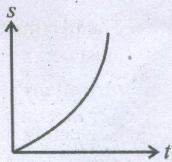 (a)
(a)the body is moving with uniform velocity
(b)the body is moving with uniform speed
(c)the body is starting from rest and moving with uniform acceleration
(d)the body is not moving at all
-
From this velocity-time graph, which of the following is correct?
 (a)
(a)Constant acceleration
(b)Variable acceleration
(c)Constant velocity
(d)Variable acceleration
-
An object of mass m held against a vertical wall by applying horizontal force F as shown in the figure.The minimum value of the force F is(a)Less than mg
(b)Equal to mg
(c)Greater than mg
(d)Cannot determine
-
A body of mass 4 m is lying in xy-plane at rest. It suddenly explodes into three pieces. Two pieces each of mass m move perpendicular to each other with equal speed v. The total kinetic energy generated due to explosion is
(a)mv2
(b)\(\frac{3}{2}\)mv2
(c)2mv2
(d)4mv2
-
Dimensional formula for work done is ________________.
(a)MLT-1
(b)ML2T2
(c)M-1L-1T-2
(d)ML2T-2
-
A rigid body rotates with an angular momentum L. If its kinetic energy is halved, the angular momentum becomes,
(a)L
(b)L/2
(c)2L
(d)L/\(\sqrt{2}\)
-
The ratio of the acceleration for a solid sphere (mass m and radius R) rolling down an incline of angle \(\theta\) without slipping and slipping down the incline without rolling is,
(a)5: 7
(b)2: 3
(c)2: 5
(d)7: 5
-
A planet moving along an elliptical orbit is closest to the Sun at distance r1 and farthest away at a distance of r2. If v1 and v2 are linear speeds at these points respectively. Then the ratio \({v_1\over v_2}\) is
(a)\({r_2\over r_1}\)
(b)\(({r_2\over r_1})^2\)
(c)\({r_1\over r_2}\)
(d)\(({r_1\over r_2})^2\)
-
The kinetic energies of a planet in an elliptical orbit about the Sun, at positions A, B and C are KA, KB and KC respectively. AC is the major axis and SB is perpendicular to AC at the position of the Sun S as shown in the figure. Then
 (a)
(a)KA > KB >KC
(b)KB < KA < KC
(c)KA < KB < KC
(d)KB > KA > KC
-
A small sphere of radius 2cm falls from rest in a viscous liquid. Heat is produced due to viscous force. The rate of production of heat when the sphere attains its terminal velocity is proportional to
(a)22
(b)23
(c)24
(d)25
-
Two thermally insulated vessels 1 & 2 are filled with air at temp (T1, T2), volume (V1, V2 & pressure (P1, P2) If the valve going to the 2 vessels is opened, the temperature on the inside of the vessel at equilibrium will be ______________.
(a)T1 + T2
(b)\(\frac { { T }_{ 1 }+{ T }_{ 2 } }{ 2 } \)
(c)\(\frac { { T }_{ 1 }{ T }_{ 2 }\left( { P }_{ 1 }{ V }_{ 1 }+{ P }_{ 2 }{ V }_{ 2 } \right) }{ { P }_{ 1 }{ V }_{ 1 }{ T }_{ 2 }+{ P }_{ 2 }{ V }_{ 2 }{ T }_{ 1 } } \)
(d)\(\frac { { T }_{ 1 }{ T }_{ 2 }\left( { P }_{ 1 }{ V }_{ 1 }+{ P }_{ 2 }{ V }_{ 2 } \right) }{ { P }_{ 1 }{ V }_{ 1 }{ T }_{ 1 }+{ P }_{ 2 }{ V }_{ 2 }{ T }_{ 2 } } \)
-
Assuming that the frequency \(\gamma\) of a vibrating string may depend upon
(i) applied force (F)
(ii) length (I)
(ill) mass per unit length (m), prove that \(\gamma\alpha{{1}\over{l}}\sqrt{{{F}\over{m}}}\) using dimensional analysis. -
Find the magnitude of vector 3\(\hat { i } -2\hat { j } +\sqrt { 3 } \hat { k } \) ?
-
Imagine that the gravitational force between Earth and Moon is provided by an invisible string that exists between the Moon and Earth. What is the tension that exists in this invisible string due to Earth's centripetal force? (Mass of the Moon = 7.34\(\times\)1022 kg, Distance between Moon and Earth = 3.84 \(\times\) 108m).
-
A particle strikes a horizontal frictionless floor with a speed u at an angle \(\theta\) with the vertical and rebounds with the speed v at an angle φ with an vertical. The coefficient of restitution between the particle and floor is e. What is the magnitude of v?

-
Calculate moment of inertia with respect to rotational axis xx' in following figures (a) and (b).
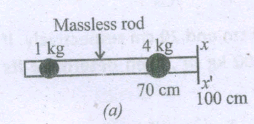
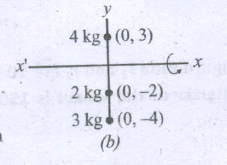
-
What is the gravitational potential energy of the Earth and Sun? The Earth to Sun distance is around 150 million km. The mass of the Earth is 5.9\(\times\)1024 kg and mass of the Sun is 1.9\(\times\)1030 kg.
-
A comet orbits the sun in highly elliptical orbit. Does a comet has a constant.
(i) Lineal speed
(ii) Angular momentum
(iii) Total Energy throughout its orbit -
Consider the following cyclic process consist of isotherm, isochoric and isobar which is given in the figure.
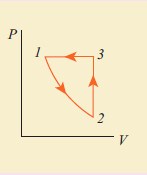
Draw the same cyclic process qualitatively in the V-T diagram where T is taken along x direction and V is taken along y-direction. Analyze the nature of heat exchange in each process.
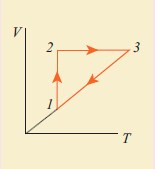
-
Define the Avogadro's number?
-
In a physical units, how many units are there in 1 metre?
1 parallactic second (parsec) = 3.08\(\times\)1016 m
Given data:
1 AU = 1.496\(\times\)1011m
1 ly = 9.467\(\times\)1015m
1 mm = 10-6m
1 parsec = 3.08\(\times\)1016m -
Find the dimensions of a and b in the formula \(\left[ P+{{a\over V^2}} \right][V-b]=RT\) where P is pressure and V is the volume of the gas
-
When an object is moving with veritable acceleration then the object possesses different accelerations at different instants. The acceleration of the object at a given instant of time or at a given point of motion is called instantaneous acceleration.
-
Two vectors \(\vec A\) and \(\vec B\) are given in the component form as \(\overrightarrow { A } =5\hat { i } +7\hat { j } -4\hat { k } \) and \(\overrightarrow { B } =6\hat { i } +3\hat { j } +2\hat { k } \). Find \(\vec { A } +\vec { B } ,\vec { B } +\vec { A } ,\vec { A } -\vec { B } ,\vec { B } -\vec { A } \)
-
A cricket ball of mass 35 g hits a stumps at an angle of 30° with a velocity of 20 m/s. If the ball rebounds at 60° the to the direction of incidence, calculate the impulse received by the cricket ball.
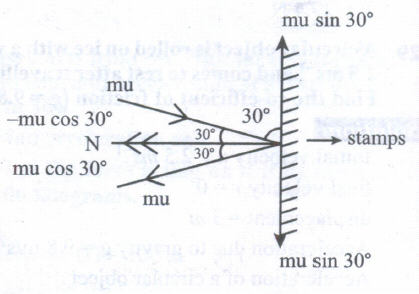
-
The following graph shows a V-T graph for isobaric processes at two different pressures. Identify which one occurs at higher pressure.
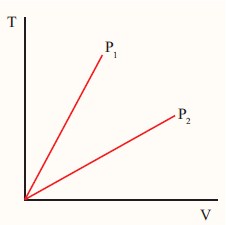
-
Apply Newton's second law to a mango hanging from a tree. (Mass of the mango is 400 gm).
-
A metal plate of area 2.5\(\times\)10-4m2 is placed on a 0.25\(\times\)10-3m thick layer of castor oil. If a force of 2.5 N is needed to move the plate with a velocity 3\(\times\)10-2m s-1, calculate the coefficient of viscosity of castor oil.
Given: A = 2.5\(\times\)10-4 m2, dx = 0.25\(\times\)10-3 m, F = 2.5N and dv = 3×10-2 m s-1 -
A vehicle of mass 1250 kg is driven with an acceleration 0.2 along a straight level road against an external resistive force 500 N. Calculate the power delivered by the vehicle's engine if the velocity of the vehicle is 30 ms-1.
-
-
Two vectors \(\vec A\) and \(\vec B\) of magnitude 5 units and 7 units respectively make an angle 60° with each other as shown below. Find the magnitude of the resultant vector and its direction with respect to 7 unit the vector \(\vec A\).
.png)
-
Consider a circular leveled road of radius 10m having coefficient of static friction 0.81. Three cars (A, B and C) are travelling with speed 7 ms-1, 8 m s-1 and 10 ms-1 respectively. Which car will skid when it moves in the circular level road? (g = 10 m s-2).
-
-
-
What is inelastic collision? In which way it is different from elastic collision. Mention few examples in day to day life for inelastic collision.
-
A molecule in gas container hits the wall with speed 350 m/s at an angle 45° with the normal and rebound with the same speed. Is momentum conserved in the collision?
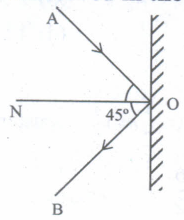
-
-
-
Two point masses 3 kg and 5 kg are at 4 m and 8 m from the origin on X-axis. Locate the position of center of mass of the two point masses
(i) from the origin and
(ii) from 3 kg mass. -
Explain in detail the geostationary and polar satellites.
-
-
-
State and prove Pascal’s law in fluids?
-
Eiffel tower is made up of iron and its height is roughly 300 m. During winter season (January) in France the temperature is 2°C and in hot summer its average temperature 25°C. Calculate the change in height of Eiffel tower between summer and winter. The linear thermal expansion coefficient for iron α = 10 x 10-6 per °C.
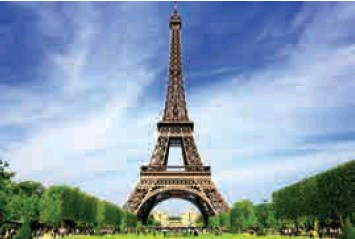
-
-
-
-
Two resistors of resistances R1= 150 ± 2 Ohm and R2 = 220 ± 6 Ohm are connected in parallel combination. Calculate the equivalent resistance.
Hint:\(\frac{1}{R'}=\frac{1}{R_1}+\frac{1}{R_2}\) -
The velocity-time graph of an object moving along a straight line is as shown.
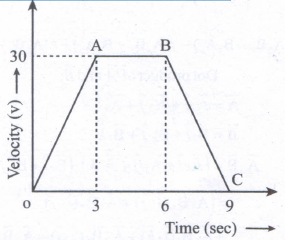
Calculate distance covered by object between t =0 to t = 3 and t = 0 to t = 6.
-
-
A man of mass 50 kg is standing at one end of a boat of mass 300 kg floating on still water. He walks towards the other end of the boat with a constant velocity of 2 ms-1 with respect to a stationary observer on land. What will be the velocity of the boat,
(a) with respect to the stationary observer on land?
(b) with respect to the man walking in the boat?
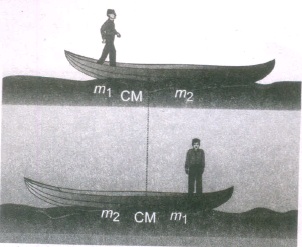
[Given: There is friction between the man and the boat and no friction between the boat and water].
-
Part A
Answer all the questions
15 x 1 = 15
Part B
Answer any six of the following in which question no.20 is compulsory.
6 x 2 = 12
Part C
Answer any six of the following in which question no.33 is compulsory.
6 x 3 = 18
Part D
Answer all the questions.
5 x 5 = 25






 11th Standard Physics Syllabus
11th Standard Physics Syllabus  11th Standard Physics Study Materials
11th Standard Physics Study Materials 11th Standard Physics MCQ Practise Tests
11th Standard Physics MCQ Practise Tests 

Reviews & Comments about 11th Physics Half Yearly Model Question Paper - 1
Write your Comment